Acute Myeloid Leukemia (AML): Romayne's Story

Romayne Kaffen
Delaware, Ohio
Acute Myeloid Leukemia
Transplanted in 2021
Many thanks to The Ohio State University Comprehensive Cancer Center- Arthur G. James Cancer Hospital and Richard J. Solove Research Institute (OSUCCC-James) and the American Society for Transplantation and Cellular Therapy for helping us share Romayne’s story.
Romayne Kaffen is appreciating her husband of 50 years, Neal, “We’ve been together since high school, we do everything together, even bone marrow transplant.” They laugh and Romayne continues, “Neal had to learn a lot about nursing when we came home {post-transplant} like dressing my central line. He’s an engineer, he made a list, he put on his gloves and got to work.” Her implication is clear -- Neal got the job done, beautifully.
This was just one of the many ways Romayne felt, from the first day of her diagnosis of acute myeloid leukemia (AML) in 2020, profoundly supported and accompanied in her journey back to full health. For Romayne and Neal, full health is a high bar indeed; they are active hikers and bikers who enjoy gardening, traveling and most of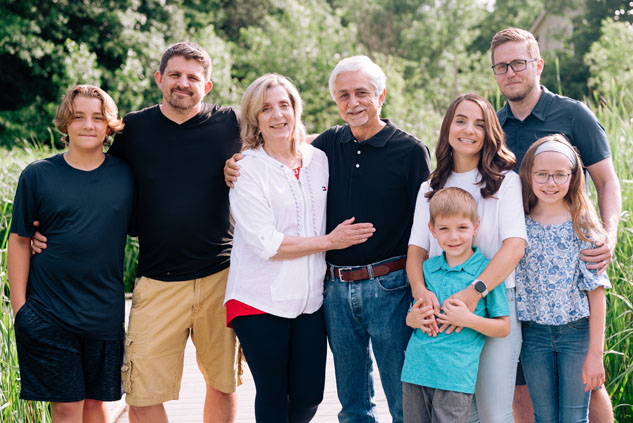 all their three lively grandchildren (ages 8, 10 and 12). Because Romayne was so physically active and strong in her 60’s, her initial illness came as a complete surprise. As she says, “I was clipping along, doing all the things I love, and then I got this funny cough, and started feeling so tired.”
all their three lively grandchildren (ages 8, 10 and 12). Because Romayne was so physically active and strong in her 60’s, her initial illness came as a complete surprise. As she says, “I was clipping along, doing all the things I love, and then I got this funny cough, and started feeling so tired.”
She went to see her primary care doctor, Dr. Taj Schall, who is, Romayne explains, “so thorough, she knew there was something wrong. It was the beginning of COVID, and when I tested negative, she sent me to The James {The James Cancer Hospital at Ohio State University}.” Romayne credits Dr. Schall’s persistence with saving her life, “She wasn’t going to let it go, she wanted to know what was wrong with me.”
At first, Romayne was diagnosed with myelodysplastic syndrome (MDS), or “smoldering leukemia.” She had reason to hope it would not progress; genetic tests indicated a low risk. Then, as Romayne recalls, “I was called in for this unexpected visit… my doctor at The James, Dr. Allison Walker, said I now had AML. I knew very little about leukemia except that it was deadly. I thought it was the end of the road. I think that’s the only time I cried in the office… But Dr. Walker said, ‘Wait a minute, I have a plan. And if the first plan doesn’t work, I have another.’ Everything at that moment changed. She offered me hope, she took me off the floor!”
Ultimately, Dr. Walker needed to use her secondary plan, she referred Romayne for transplant. With characteristic good fortune, Romayne again found herself in the care of a skilled, empathic practitioner, Dr. Hannah Choe. “She’s wonderful,” Romayne says, “whenever I have a problem I feel confident she’ll find a solution.” The first solution Dr. Choe provided was an unrelated, anonymous donor who matched Romayne sufficiently that she did extremely well through transplant.
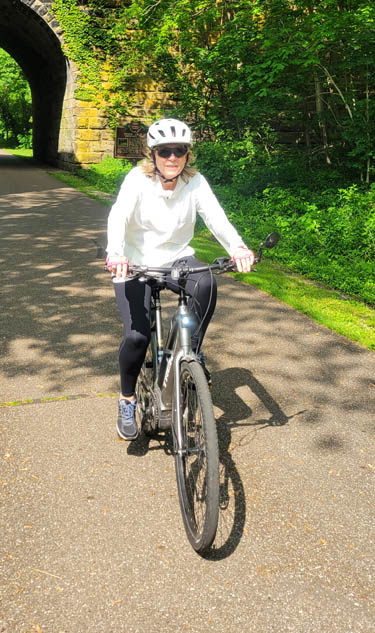
Romayne and Neal brought the same physical zeal they bring to everyday life to their time on the transplant unit. Romayne recalls, “There was a little gym, we’d go there every day. We’d walk around and around the floor. We just kept moving.” She continues, “For me, I was very fortunate, I always say to Dr. Choe, it wasn’t that bad!” While she understands that her relatively easeful time through transplant is more the exception than the rule, Romayne is committed to reassuring fellow patients that their experience might be less harrowing than they fear. “I was recently in the bathroom at the James,” Romayne says, “washing my hands beside a woman who was terrified. I told her and I tell everyone — it might be easier than you imagine.”
Of course, not every moment was easy. Romayne found it particularly unsettling, as many women do, to lose her hair. “Losing your hair is traumatic,” Romayne recalls. She told the staff she would be an exception, the one patient who didn’t lose her hair. In response, “they just kinda looked at me and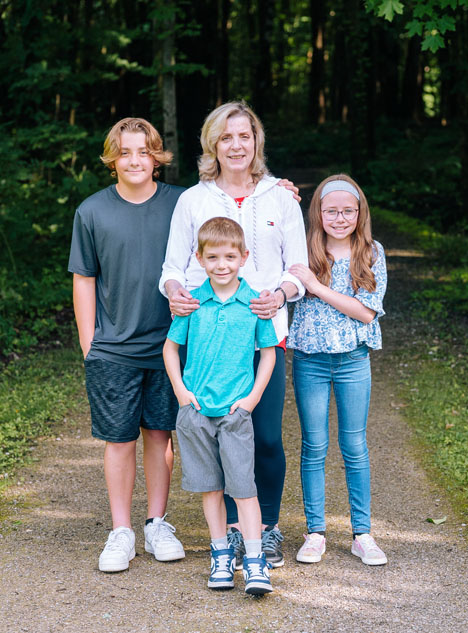 smiled. For a week or so it was fine, and then it started to fall out in big clumps. Finally, I said to Neal get the clippers and he cut it all off.” Wigs were her salvation. “No one saw me without hair,” Romayne notes, “except Neal! When I got that wig, most people didn’t know. My grandkids didn’t know. But once I had my wig, I was fine.”
smiled. For a week or so it was fine, and then it started to fall out in big clumps. Finally, I said to Neal get the clippers and he cut it all off.” Wigs were her salvation. “No one saw me without hair,” Romayne notes, “except Neal! When I got that wig, most people didn’t know. My grandkids didn’t know. But once I had my wig, I was fine.”
Through hair loss, gym workouts and the occasional bad day, Neal was her rock of constancy and caring. Happily, Neal had caregivers of his own – their two adult children, son Richard and daughter Kristin -- who live within minutes (Kristin just ten houses away!). When Romayne retired from teaching 3rd and 4th grade for Columbus City Schools, a job that was “tremendously challenging, fulfilling, and rewarding,” they sold the horse farm where they’d lived for forty years to move closer to their children. This was an incredible stroke of 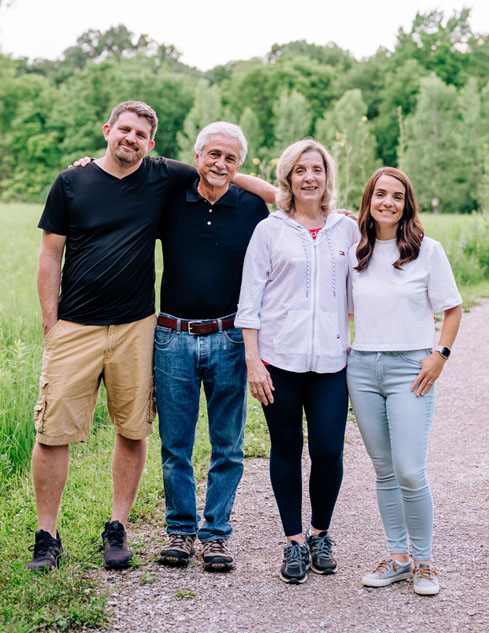 luck. As Romayne describes, “The kids were such a comfort to Neal. Supporting me through the whole experience was pretty rough, and they were there for him… My daughter had dinner ready when he came home from the hospital. Every single day.”
luck. As Romayne describes, “The kids were such a comfort to Neal. Supporting me through the whole experience was pretty rough, and they were there for him… My daughter had dinner ready when he came home from the hospital. Every single day.”
Living close by also meant being buoyed by the high spirits of their grandchildren. While Romayne was still immune suppressed, it was hard not to hug them. “We’re a huggy family!” she explains. But as her full health has returned, so have the hugs. These days, the whole family is anticipating a fun-filled trip together. “The kids want to go to Disneyworld in September and Grandma’s gonna be there,” Romayne says. “Hot, in her long sleeve shirt {Romayne has to protect her skin from the sun}. But I have no problem any other way, physically. I can go forever!” It’s clear Romayne feels reinvigorated on every level.
“I’ll tell you one thing,” she says, “every morning I wake up and I’m thankful and I say: I am not going to waste this day. I’m going to do something I really want to do.

As one of the premier cancer hospitals and research institutes in the United States, The Ohio State University Comprehensive Cancer Center – James Cancer Hospital and Solove Research Institute is home to one of the nation’s leading Blood and Marrow Transplant and Cellular Therapy programs. Since its inception in 1984, the program has grown to be nationally and internationally recognized for the caliber and expertise of its physicians and staff. The program is accredited by the Foundation for the Accreditation of Cellular Therapy (FACT), which provide evidence-based requirements set by teams of world-renowned experts vested in the improvement and progress of cellular therapy. Additionally, the nursing team has been nationally recognized multiple times for exceptional patient care by the American Association of Critical-Care Nurses and is a Magnet® accredited program.
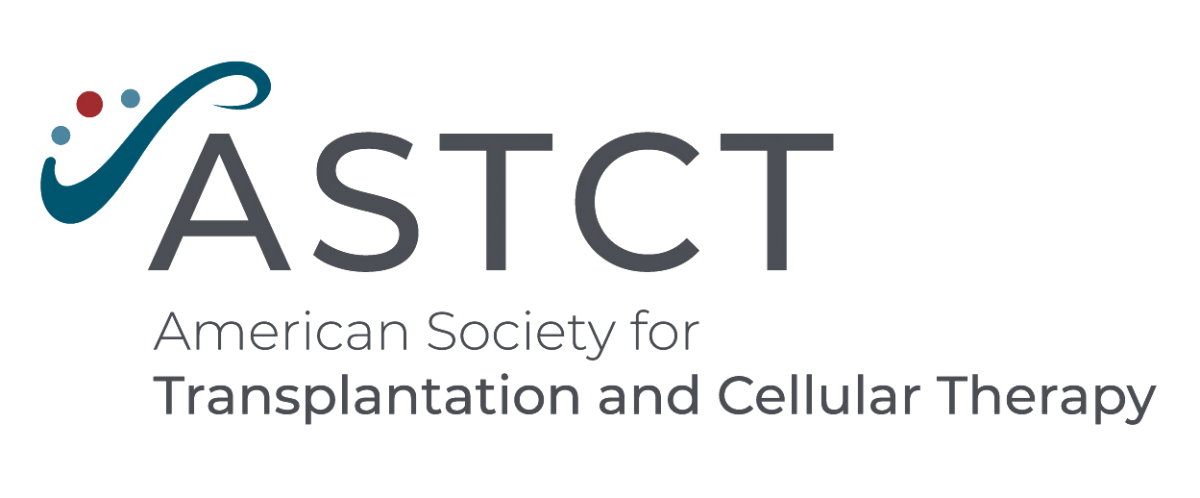
The American Society for Transplantation and Cellular Therapy (ASTCT), formerly known as the American Society for Blood and Marrow Transplantation, is a professional society of more than 2,200 healthcare professionals and scientists from over 45 countries who are dedicated to improving the application and success of blood and marrow transplantation and related cellular therapies. ASTCT strives to be the leading organization promoting research, education, and clinical practice to deliver the best, comprehensive patient care.
Photo Credit: Mallory Frentsos Delaware, OH mallorymademedia.com